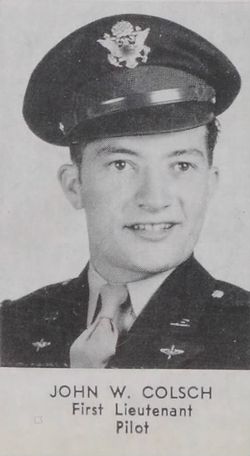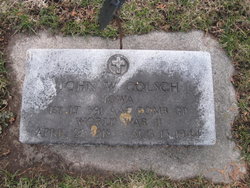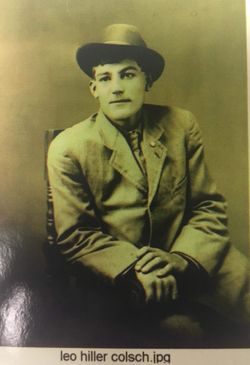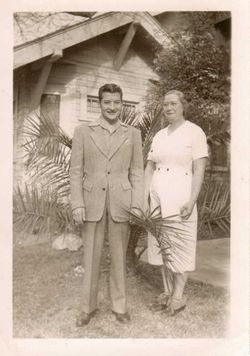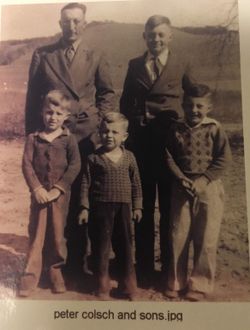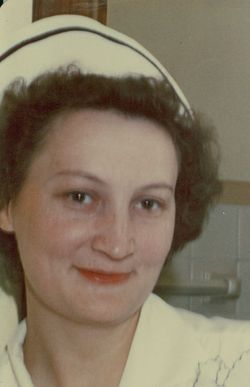| Description |
: |
To find this monument: Crucifix in center separates front and back half, this monument can be found in the back half of the front half. Or go to the crucifix in the center of the cemetery and start searching in front of the crucifix.
Feel free to contact me to make any additions or corrections.
Died as the result of "friendly fire" while flying his final mission before returning stateside [the United States].∼John W. Colsch
391st Bomb Group, 573rd Bomb Squadron
by Maury Gallagher © 2011
The pilot, a young First Lieutenant, certainly experienced some varied emotions as he lifted...
Read More
|
To find this monument: Crucifix in center separates front and back half, this monument can be found in the back half of the front half. Or go to the crucifix in the center of the cemetery and start searching in front of the crucifix.
Feel free to contact me to make any additions or corrections.
Died as the result of "friendly fire" while flying his final mission before returning stateside [the United States].∼John W. Colsch
391st Bomb Group, 573rd Bomb Squadron
by Maury Gallagher © 2011
The pilot, a young First Lieutenant, certainly experienced some varied emotions as he lifted his B-26 Marauder (named "Purring Panther") from the soil of England for his sixty-fifth combat mission. All but one of the crewmembers on board that day had flown with him across the seas to England six and a half months earlier. Together they had successfully completed 64 missions, and on this day, they would complete their required missions and then return home to their families and friends in the States. In the words of a crewmember on another bomber, the flak over the target that day was "terrific." But all was going well… and then the wing was blown off…
***********
John W. Colsch was born in New Albin, Iowa April 28, 1918. His parents were Leo and Nellie (Luth) Colsch. John graduated from New Albin High School and completed one year of college at Columbia College (now Loras College) in Dubuque, IA. In October 1936 he enlisted in the United States Navy and served until he received an honorable discharge in September 1940. In the Navy he served as a bombardier and gunner in Navy aircraft.
After his discharge from the Navy, John attended Curtis-Wright Aeronautical Engineering School, and was subsequently selected for Army Air Force aviation cadet training at Cal-Aero Flight Academy in Ontario, California. While at Cal-Aero, the Abbot and Costello movie "Keep ‘em Flying" was filmed on location there. John had a bit part in that movie that had him onscreen for but a few seconds. Upon completion of his training at Ontario, he was transferred to Stockton Field, CA for advanced training, and on March 19, 1942, he received his commission and silver wings. His first assignment after commissioning was to Las Vegas Army Airfield where aerial gunners were trained for combat. This assignment was apparently due to his prior experience in the Navy.
John's next assignment was to Dodge City Army Airfield in Kansas where the Army Air Forces Pilot School trained pilots on the B-25 and B-26 bombers. He was trained on the B-26 Marauder, a medium bomber. The B-26 first flew in November of 1940. It was 71 feet long, had a wingspan of 58 feet and was powered by two 1900 horsepower engines. It was armed with machine guns and could deliver a bomb load up to 4,000 pounds. It typically carried a crew of six. Many B-26's were lost during training evolutions. The problem was such that the aircraft earned the nickname "Widow Maker." So many crashed off Tampa Bay that another phrase was prominent. It said, "One a day into Tampa Bay." The aircraft had advanced technology for its time, and it was determined that only the most experienced could handle it. John's nephew, John J. Colsch, also an Air Force pilot, noted that "The B-26 was an unforgiving aircraft when it came to mistakes in the air. It was a low level bomber and was more maneuverable than the larger, four engine bombers. It was that maneuverability that left it with a smaller margin for error." Interestingly, though accidents continued in training, the aircraft had a remarkable safety record in combat.
After completing B-26 training John was transferred to MacDill Air Base near Tampa, Florida. MacDill was the home base for the 391st Bombardment Group (Medium). There were four squadrons flying the B-26 assigned to the 391st. John was assigned to the 573rd Bombardment Squadron. At some point in time, he was transferred to a Replacement Training Unit (RTU) at Lake Charles Army Airfield in Lake Charles, Louisiana. At the RTU his crew was formed and underwent training as a unit. His next move was to Hunter Field in Savannah, Georgia where his crew received additional training and was assigned an aircraft, which they prepared for overseas flight and combat.
After operating and training at Myrtle Beach Bombing Range in South Carolina during the latter half of 1943, the 391st Bomb Group began preparations for deployment overseas. The first week of January 1944, the aircraft departed West Palm Beach, Florida on a trip that would take them through Puerto Rico, British Guiana, Brazil, Ascension Island, Liberia, Senegal, and French Morocco before finally arriving at ST. Mawgan, England on January 30, 1944. They then flew to their initial operating base at Matching, England. The ground crews had arrived a few days earlier after traveling from New York by ship. They would remain at Matching until October 1944 when they would move to a base in France.
There is little information available to reflect which specific missions John flew on or what targets he struck. The 391st Bomb Group flew its first combat mission on February 16, 1944. That mission, and another five days later, were recalled because of bad weather over the targets. The first bombs were dropped February 23rd on an airfield in Holland. Missions that followed targeted airfields, railroad facilities, communications facilities, bridges etc., primarily north of Paris and in Belgium. As D-Day approached, emphasis turned to enemy facilities along the coast of Normandy, and that emphasis continued through D-Day on June 6 as the invasion unfolded.
One mission that Lt. Colsch flew on was recorded. In mid to late June 1944, Donald Grant, a reporter for the Des Moines Register, flew on a mission with John and his report was printed in the June 26, 1944 issue of the Register. "A few moments ago," he wrote, "I was sitting in a Marauder medium bomber watching a German army headquarters go up in smoke. Flying the plane I rode in was Lt. John Colsch of New Albin, Iowa. He enjoyed the sight too." He went on to note that "It all began last night when Col. Gerald Williams, commander of this Marauder group, started telling me about his Iowa boys, including Colsch, whom he said is ‘quiet around the base, but a demon in the air.' So the next thing I knew, this afternoon I was being issued a lot of heavy, uncomfortable equipment and hurrying over to the briefing hut with Lt. Colsch and the crew of his plane that day ‘San Antonio Rose.'"
Grant went on to write about the hundreds of ships coming and going across the English Channel, the lines of equipment and supplies on the Normandy beaches, and the concentrations of allied forces along their route to Cherbourg, where their target for the day was situated. "It looked to me as if all the goods in the world were moving against the Germans today. But Colsch said it was like that everyday." He wrote about the flak which seemed heavy enough at times to park the airplane on, and some of which "bounced around" in his airplane without causing injuries. "How we got through I can't just say but these boys just know how to do those things. It was Colsch's 44th mission today so he isn't exactly an amateur." He wrote that the planes were so close together that the wings nearly touched,.he wrote about the "Ghost Ship" that tried to join their formation on the trip home.
"The ghost ship," he wrote, "is a captured Marauder flown by the Germans which sometimes works its way into an American formation and shoots it up. We kept the ghost at rather more than arms length with bursts of machine gun fire and reported the thing to our nearest fighter base. Pretty soon U.S. fighter planes appear above us… We left the ghost ship to them."
After the mission Grant and John Colsch had a "chat over a Red Cross doughnut." John planned to continue flying after the war, but he wanted to win in Europe and then go to Burma and fight the Japanese. "Colsch," Grant wrote, "is a quiet, smallish boy with a sweet smile which has caught notice of a British WREN whom he sees in London when on leave. He said it was all right for me to tell this because the girl he used to take to the movies in Lansing, IA, in his father's old Buick, has other plans now anyway.
"His first airplane flight in Iowa," Grant continued, "came when he was 12 and was taken for a ride by his father, Leo Colsch. That wasn't so long ago because he is only 26 now but he has seen a lot of things since then. Most interesting combat flights were low level work in the first few days after D-Day, Colsch said. He got a better view of the ground that way. Once they bombed a railroad station, smashing some freight cars loaded with German tanks. Just near the station a French woman was hanging out clothes in her backyard. ‘We circled back to see if she was all right,' Colsch said, ‘and there she was, picking up the clothes which our blasts had blown away and hanging them back on the line again.'"
Over the next month and a half, John flew twenty more missions. Then, on August 13, 1944 he once again lifted his Marauder from the soil of England. 64 times, he and his crew had done so, and this time held special significance. It was their last scheduled mission. After that day, with 65 missions complete, they could return to family and friends back home in the States.
A crewmember in another Marauder on that mission recorded what happened that day. Elmer Hansard, who hailed from Muncie, Indiana, was a Marauder tail gunner. He had been shot down on D-Day, and flew another mission the very next day. On August 13, Elmer was also marking a milestone, he was flying in "Lilly Commando" on his 69th and final mission. On a scrap of paper Elmer wrote:
"August 13, 1944. Number 69. Our last mission. We went to Druex today and bombed a bridge that was giving our boys on the ground trouble. The flak was terrific and Colsch's plane and Boyd's was knocked down, one with the tail knocked off and the other with a wing off. No one bailed out."
1st Lt John W Colsch and his crew, 2nd Lt William J Kelley, 1st Lt John F Kohler, T/Sgt Warren D Raymond, Sgt Henry A Miller and S/Sgt Verlin H Brandenberg all were killed in the crash.
It was not the flak that caused those two aircraft to fall from the sky that day. A bomb released from another aircraft above the "Purring Panther" struck the engine and blew the wing off. The aircraft flipped inverted and crashed into and cut off the tail of Lt. Boyd's aircraft. Both planes went into steep dives exploding on impact with the ground. On another scrap of paper, Elmer made a drawing that accurately depicts his and others descriptions of the immediate results of the wayward bomb. He saved those two scraps of paper for years, and then passed them down to his grandson Greg Hansard who made them available for this story. "My Grandfather talked about Lt. Colsch a lot," Greg said, "and he always brought up that fateful last mission. My grandfather passed away in August 2008. He left me with all of his letters, drawings, and paintings. He was a very talented man and a true hero to our country. He never complained. He always said he had a job to do and he did it."
John's family was notified that he was missing in action, and about a year later, August 23, 1945, they received notice that his status had been changed to a "presumptive finding of death." In his last letter home, written just two days before he died, John said that he had been assigned Flight Commander and Formation Leader of his bombing group. He noted that his crew members would be coming home the next week, but he had been asked to remain a little longer. Among other awards, he had earned the Air Medal with three silver oak leaf clusters and two Bronze Stars. The Purple Heart medal was awarded posthumously.
1st Lt. John W. Colsch was buried in St. Joseph Cemetery in New Albin August 8, 1949. The "demon in the air" was at rest.
Picture of "Purrin Panther", crew unknown:
|

